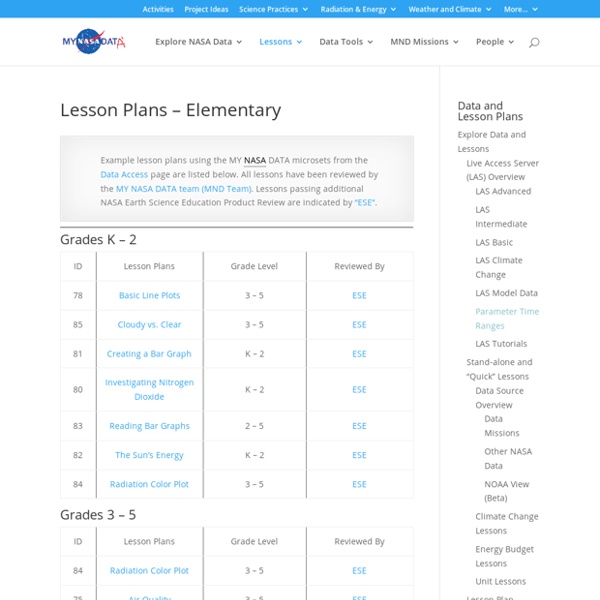



http://mynasadata.larc.nasa.gov/lesson-plans/lesson-plans-elementary-educators/
Related: General Elementary Resources100 Awesome Engineering Projects for Kids By Kristie Lewis Engineering and fun aren't always two things that kids naturally associate with one another, but there are hundreds of ways to make engineering, physics and design fun and challenging for kids. Here are 100 great experiments that will let kids construct, play, learn and grow, all while they study the fundamentals of engineering. Basics These projects focus on the basics of motion, force and other essentials of physics.
NWS Education Resources This page offers information for children, teens and adults. Materials range from coloring books, puzzles and games, to lesson plans, brochures, satellite images, and career information for weather related fields, such as meteorology, hydrology and climatology. Classroom Materials Student Sites Graphics, Photos, Images
The Reason for the Seasons - National Geographic Society 1. Activate prior knowledge about seasons and sunlight.Explain to students that the Earth orbits an ideal distance from the sun, and this affects the weather we experience here on Earth. Ask: What are the different seasons? Write the sequence of the seasons on the board for students’ reference: winter, spring, summer, autumn. Teaching_strategies Natural Hazards• ELI Natural Hazards category Plate tectonicsPlate tectonics - whole concept:-• Partial melting - simple process, huge global impact (ELI+)• Partial melting model and real rock (ELI+)• Plate riding (ELI+)• Plate tectonics through the window (ELI+)• Plate margins and movement by hand Evidence and explanation for the theory:-• Continental jigsaw puzzle (ELI+)• Earth time jigsaw puzzle• Geobattleships (ELI+)• Wegener’s ‘Continental drift’ meets Wilson’s ‘Plate tectonics’ (ELI+)• Did the continents move for you?
Best Science Experiments for Kids It is no secret that Science is one of our favorite subjects around here. As a kid myself, I was always interested in science and discovery. As a teacher, it was one of my favorite subjects, and well… now that I have kids, it is one of their favorite subjects as well. The thing about science, is that it can be intimidating, seem overwhelming with terms, and sometimes downright messy. But want to know the secret? Science is everywhere and science can be and is extremely fun! The best educational iPad apps for kids Overview A six year old boy and his meteorologist dad set out to produce an app that would appeal to young children and have educational value. They succeeded and created this fantastic app that teaches children about weather. This practical app allows children and adults to keep track of weather forecasts around the world and look at an avatar who dresses accordingly. Ultimately children are encouraged to use this app alongside a parent as an everyday tool for dressing appropriately and looking at trends in the weather. Children and adults read facts about the weather, check the weather in places all over the world, look at weather appropriate clothing, view the temperature in Fahrenheit and Celsius and graph their findings to compare their results.
Science Teaching Junkie: Clearest Way to Teach Moon Phases...EVER! This moon phase board was fairly easy to make. After making a run to the Dollar Tree and rummaging through our science storeroom to collect the needed supplies to make this, it was pretty inexpensive and so worth every penny! Essentially, this Moon Phase board allows students to visualize and better understand the cause of moon phases and comprehend the 2 different views that are often given on a diagram (view from space and view from the Earth). Up to this point, I've done a Lunar Lollipop Investigation, which I thought was great, but this beats it by a long shot! A large majority of my students don't really understand why the lit part of the moon doesn't face the sun on part of the view as seen from Earth on every moon phase diagram (see below). Even though I give many different examples and explanations, I still see a puzzled look on several of the students' faces.
Exploring Alternative Forms Of Energy Unit This module’s essential challenge focuses on building and optimizing wind turbines. Students engage in a series of investigations to determine how wind turbines work. After investigating the concepts of energy transformation and the speed and force of objects, students engage in a design challenge in which they build and optimize wind turbine blades to produce the greatest energy output. Through this module, students build an understanding of the idea that energy can be converted from one form into another. Curriculum - Science / Science & Engineering Practices District Home d Sign In Birthday Moons Students become familiar with lunar phases by locating and then graphing the Moon phase of their own birthdays. After listening and discussing lunar myths and legends they create their own Birthday Moon Stories. The learner will: generate a birthday moon for his/her birth date this year and the previous year using various web sites. classify his/her birthday moon and produce a "moon card" of his/her own birthday moon recognize and describe the patterns of the Moon's phases.
Elementary GLOBE - GLOBE.gov Overview Elementary GLOBE is designed to introduce primary (K-4) students to the study of Earth System Science. The complete instructional unit includes: Science-based storybooks designed to introduce students to key concepts in water, soil, clouds, seasons, aerosols, and Earth system studies. Classroom learning activities complementing the science content covered in each storybook that are designed to further engage students in GLOBE's 5 investigation areas. Elementary Curriculum Resources Energy Infobooks are the resource for many NEED activities and include an introduction to energy, information on major sources of energy, new technologies, energy conservation, electricity, climate change, and other energy information. They are available on four reading levels and are revised and updated annually. Blueprint for Success (e-publication) This essential gusdide helps educators develop effective energy education programs.
Grade 1.pdf Columbus City Schools 2015-2016 2 Revised 2015 Misconceptions